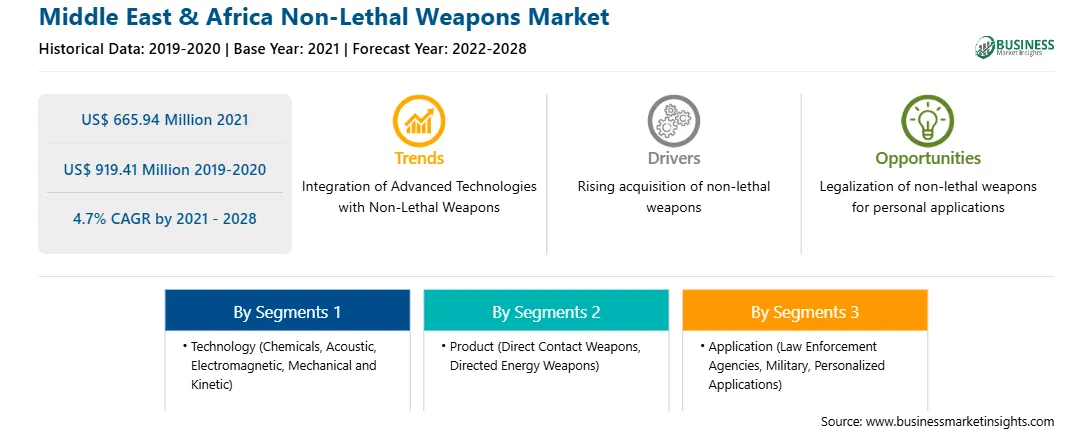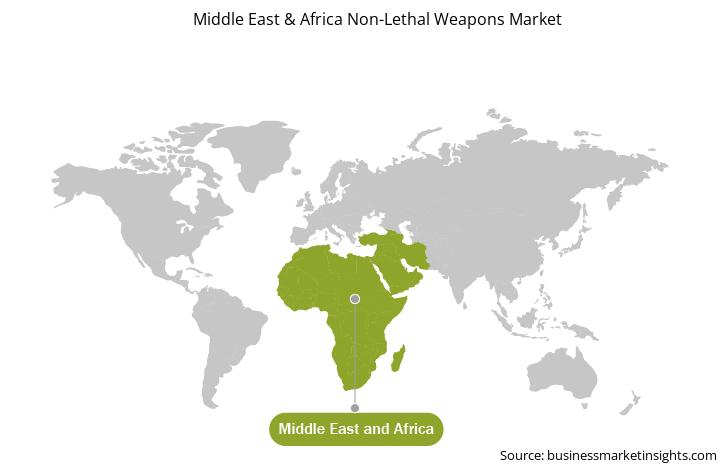Non-lethal weapons have become more popular because of their advanced features and capacity to calm riots without causing casualties. Defense firms and key market players improved their product portfolios with advanced technologies, including laser interdiction systems, long-range acoustic devices, upgraded underwater loudhailers, flash-bang grenades, acoustic hailing devices, modular crowd control weapons, and tasers. These technology integrations in non-lethal weapons propel the growth of the non-lethal weapons market. Companies started developing weapons that are less lethal with technologies, including tasers. Taser-technology-integrated non-lethal weapons are electroshock weapons that overpower the peripheral nervous system. The most belligerent suspects are powerless to resist only if their electrode darts make good contact with suspects. Moreover, a defense department program is putting five new techniques to the test for developing non-lethal weapons, including the laser-induced plasma effect, carbon nanotube thermophone, pre-emplaced electric vehicle stopper, variable kinetic system, and maritime vessel stopping occlusion technology, to subdue enemies without killing them. Thus, these new technology integrations with non-lethal weapons are contributing to the growth of the non-lethal weapons mark.
With the new features and technologies, vendors can attract new customers and expand their footprints in emerging markets. This factor is likely to drive the MEA non-lethal weapons market. The MEA non-lethal weapons market is expected to grow at a good CAGR during the forecast period.
Strategic insights for the Middle East & Africa Non-Lethal Weapons provides data-driven analysis of the industry landscape, including current trends, key players, and regional nuances. These insights offer actionable recommendations, enabling readers to differentiate themselves from competitors by identifying untapped segments or developing unique value propositions. Leveraging data analytics, these insights help industry players anticipate the market shifts, whether investors, manufacturers, or other stakeholders. A future-oriented perspective is essential, helping stakeholders anticipate market shifts and position themselves for long-term success in this dynamic region. Ultimately, effective strategic insights empower readers to make informed decisions that drive profitability and achieve their business objectives within the market.

| Report Attribute | Details |
|---|---|
| Market size in 2021 | US$ 665.94 Million |
| Market Size by 2028 | US$ 919.41 Million |
| CAGR (2021 - 2028) | 4.7% |
| Historical Data | 2019-2020 |
| Forecast period | 2022-2028 |
| Segments Covered |
By Technology
|
| Regions and Countries Covered | Middle East and Africa
|
| Market leaders and key company profiles |
|
The geographic scope of the Middle East & Africa Non-Lethal Weapons refers to the specific areas in which a business operates and competes. Understanding local distinctions, such as diverse consumer preferences (e.g., demand for specific plug types or battery backup durations), varying economic conditions, and regulatory environments, is crucial for tailoring strategies to specific markets. Businesses can expand their reach by identifying underserved areas or adapting their offerings to meet local demands. A clear market focus allows for more effective resource allocation, targeted marketing campaigns, and better positioning against local competitors, ultimately driving growth in those targeted areas.

The MEA non-lethal weapons market is segmented based technology, product, application, and country. Based on technology, the market is segmented into chemicals, acoustic, electromagnetic, and mechanical and kinetic. The mechanical and kinetic segment dominated the market in 2020 and electromagnetic segment is expected to be fastest growing during forecast period. Based on product, the market is segmented into direct contact weapons and directed energy weapons. The direct contact weapons segment dominated the market in 2020 and directed energy weapons segment is expected to be fastest growing during forecast period. Based on application, the market is segmented into law enforcement agencies, military, and personalized applications. The law enforcement agencies segment dominated the market in 2020 and military segment is expected to be fastest growing during forecast period. Based on country, the MEA non-lethal weapons market is segmented into South Africa, the UAE, Saudi Arabia, and the Rest of the MEA.
Axon Enterprise, IncCombined Systems, Inc.; Condor Non-Lethal Technologies; FN Herstal; ISPRA by EL Ltd.; Lamperd Less Lethal; PepperBall; and Rheinmetall AG are among the leading companies in the MEA non-lethal weapons market.
The Middle East & Africa Non-Lethal Weapons Market is valued at US$ 665.94 Million in 2021, it is projected to reach US$ 919.41 Million by 2028.
As per our report Middle East & Africa Non-Lethal Weapons Market, the market size is valued at US$ 665.94 Million in 2021, projecting it to reach US$ 919.41 Million by 2028. This translates to a CAGR of approximately 4.7% during the forecast period.
The Middle East & Africa Non-Lethal Weapons Market report typically cover these key segments-
The historic period, base year, and forecast period can vary slightly depending on the specific market research report. However, for the Middle East & Africa Non-Lethal Weapons Market report:
The Middle East & Africa Non-Lethal Weapons Market is populated by several key players, each contributing to its growth and innovation. Some of the major players include:
The Middle East & Africa Non-Lethal Weapons Market report is valuable for diverse stakeholders, including:
Essentially, anyone involved in or considering involvement in the Middle East & Africa Non-Lethal Weapons Market value chain can benefit from the information contained in a comprehensive market report.